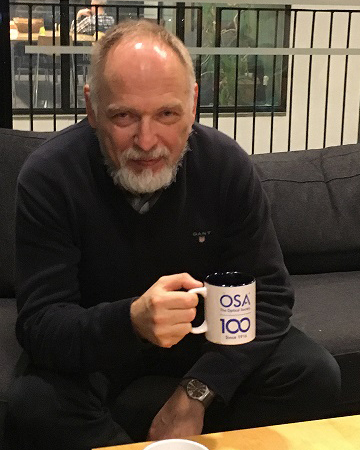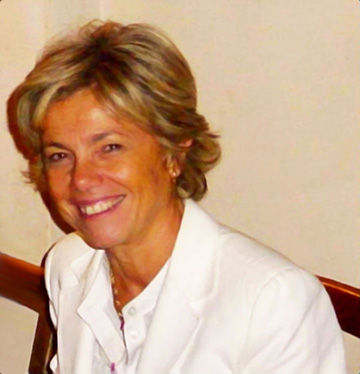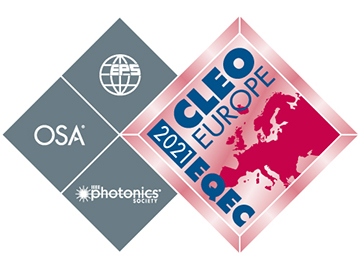In mid-February 2021, the European photonics community got some disappointing news. Messe München, the organizer of the world’s largest photonics trade fair, Laser World of Photonics, announced that the gigantic, biennial show would not take place this year, but would be put off until April 2022 owing to the pandemic emergency. There was a silver lining, however. The World of Photonics Congress—five top-tier scientific conferences usually co-located in Munich with the Laser trade show—would proceed on schedule from 20 to 25 June 2021, as a 100% virtual event.
The decision to move forward with the congress left open the promise of great scientific exchange, albeit online. But the sudden switch from planning a live to a 100% virtual event, only four months before the congress, required quick thinking and adaptability on the part of the organizers. How did it go? To find out, OPN talked with OSA Fellows Valdas Pasiskevicius and Concita Sibilia, the co-chairs of one of the key components of the World of Photonics Congress, CLEO/Europe.
A European flavor
Managed by the European Physical Society (EPS) and co-sponsored by EPS, The Optical Society (OSA) and the IEEE Photonics Society, CLEO/Europe shines the spotlight every two years on cutting-edge research in applied physics, optical engineering and photonic and laser applications. It’s presented in conjunction with the European Quantum Electronics Conference (EQEC), a complementary event that focuses on basic research in laser physics, nonlinear optics and quantum optics.
As the name implies, one thing CLEO/Europe offers is a uniquely European slant. “It has a different flavor” both from the original CLEO Conference in the United States and from the CLEO/Pacific Rim conference, according to Pasiskevicius. One reason, he says, is that “funding is different and the topics that are emphasized are slightly different” between the photonics communities in the three regions. “So the meetings are complementary.”
Both of the co-chairs for the 2021 conference have a long history with CLEO/Europe. Pasiskevicius, currently affiliated with KTH–Royal Institute of Technology, Sweden, says he attended the first CLEO/Europe–EQEC conference event, in 1994. “It made a huge impression on me, and I’ve been going since then.” From 2013 on he has also worked on the meeting program, as a committee member, program co-chair and, this year, general co-chair.
Sibilia, now with La Sapienza Università di Roma, Italy, has been involved with CLEO/Europe for almost 10 years as a participant on technical committees, a program co-chair, and general co-chair. “It has been a really nice experience,” she says. “This kind of conference has been very important for my career.”
Changing tack and ramping up

Valdas Pasiskevicius. [Courtesy of V. Pasiskevicius]
Those years of previous involvement, though, offered little preparation for the unique challenges of the pandemic.
“I was kind of optimistic when I agreed to be a coordinating chair,” Pasiskevicius recalls, noting that there was “a little bit of excitement” about the many unknowns as the conference was being planned. But as 2020 ended and 2021 began, things seemed even more opaque.
“Essentially, our submission deadlines were approaching,” he says, “but we couldn't tell anyone in which form [live or virtual] the conference would be held.” Then, Messe München announced that the Laser trade fair would be canceled, and the organizers of CLEO/Europe and the other components of the World of Photonics Congress transitioned to planning for an online event.
The decision from Messe München “was wise,” says Pasiskevicius. “But we were essentially left on thin ice—the message was, ‘Do what you want,’ more or less.” And it meant a heavy lift for the organizers to coordinate with the other World of Photonics meetings to keep the event unified, organize joint online conferences and more.
“The decision and the organization took a lot of time,” Sibilia says, “and Valdas spent really a lot of time in planning all of the meeting.” She also credits the EPS staff managing the event. “We have to acknowledge them, because they did really great work … It is not simple to manage this kind of event.”
Pasiskevicius had positive words for another CLEO/Europe co-sponsor as well—OSA, to which the organizers reached out for technical help and advice. Indeed, CLEO/Europe ended up adopting the software platform built by OSA to empower the May 2021 CLEO/US conference. “EPS and OSA worked hard together to make this software platform ready … It is pretty good, I must say.”
Hot topics

Concita Sibilia. [Courtesy of C. Sibilia]
For all of the logistical and technical challenges, Sibilia, Pasiskevicius and their colleagues still found time for their most important job: developing a first-rate program. And part of that involves keeping an eye out, during the planning process, for potentially hot, interdisciplinary topics that might not fall within the scope of one of the usual meeting subcommittees. “Of course, it’s impossible to totally anticipate them,” Pasiskevicius admits. “But we try to determine areas in our planning that we think might be interesting.”
Five such hot-topic areas—nanophotonics, high-field terahertz, attochemistry, deep learning and flexible photonics—were rolled into special joint symposia for the 2021 meeting. These topics, both Sibilia and Pasiskevicius believe, underscore the meeting’s usefulness in identifying and supporting emerging areas. “A few years ago, if you said ‘attochemistry,’ people would ask ‘What do you mean by that term?,’” Pasiskevicius notes. “Now, we have a whole bunch of people working in this field who can answer that question.”
There was also much intriguing new research in the meeting’s regular sessions. Sibilia—whose own work focuses on nonlinear optics and optical materials—found considerable interest in the sessions that centered on the emerging material platform of perovskite, not just for photovoltaics but for other applications. And both she and Pasiskevicius were impressed by developments reported for pulsed lasers in the mid-infrared. “We’re seeing huge progress there,” Pasiskevicius says. “Really high peak powers; really, really nice results. I’m amazed by how much progress people have made during the COVID crisis.”
Pluses and minuses
When OPN spoke with Pasiskevicius and Sibilia, the CLEO/Europe conference was only half done. But while that was too early to access full-conference statistics, anecdotal evidence from colleagues and preliminary survey feedback suggested to them that the event had been well received, with few technical glitches.
Nonetheless, in the wake of the experience of planning and launching the 2021 virtual conference, both of its co-chairs have decidedly mixed feelings on the virtual format. They acknowledge some clear advantages—the elimination of travel, for example, which obviously is good for both budget and the environment; and the availability of recorded sessions, which makes it easy to go back and review talks one may have missed. Nonetheless, like many others, both Sibilia and Pasiskevicius keenly miss aspects of in-person meetings that are difficult to reproduce online.
“It is a strange situation—a really unusual experiment, let us say,” Sibilia observes. And, she believes, the lack of personal interaction in an online meeting, in contrast to a live one, is a significant disadvantage, especially for the young scientists who need the face time that a live meeting allows. “Today, at the poster session, there was quite a good interaction,” she says. “But it's not the same as being in the poster session on site.”
Pasiskevicius agrees. “Mingling [in person] is important,” he says. “Ideas happen, projects happen in that mingling, and that is difficult to replace.”
A hybrid future?
So what will the meeting of the future look like? “Of course, we can’t forget this [pandemic] experience,” Pasiskevicius says. “It will be on everyone’s minds as future conferences are organized.”
The likeliest outcome, he and numerous others believe, is some sort of hybrid conference combining live and virtual experiences. This will make it particularly important, he thinks, for meeting organizers to keep abreast of developments in software and platforms to support such events. “You have to keep an open mind,” he maintains. “For some conferences, especially small, single-session conferences,” virtual meetings may be best, especially if it can be “made easier to arrange socializing online.” But for large, multisession conferences, he says, “virtual might not be the best solution,” and a live component will once again emerge after the pandemic.
For now, however, Pasiskevicius believes that the virtual option allowed him, Sibilia and the other conference organizers to put together a valuable experience for attendees. “It’s a really, really nice conference,” he concludes. “Although this format is not ideal, people are gaining a lot from it.”

